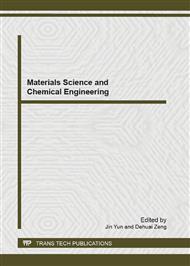[1]
B O'Regan, M Grätzel, A low-cost, high-efficiency solar cell based on dye-sensitized colloidal TiO2 films, Nature. 353 (1991) 737-740.
DOI: 10.1038/353737a0
Google Scholar
[2]
B. Tan, Y.Y. Wu, Dye-Sensitized Solar Cells Based on Anatase TiO2 Nanoparticle/Nanowire Composites, J. Phys. Chem. B 110 (2006) 15932–15938.
DOI: 10.1021/jp063972n
Google Scholar
[3]
S. Ito, T. N. Murakami, M. Grätzel, Fabrication of thin film dye sensitized solar cells with solar to electric power conversion efficiency over 10%, Thin Solid Films 516 (2008) 4613–4619.
DOI: 10.1016/j.tsf.2007.05.090
Google Scholar
[4]
S. Hore, P. Nitz, R. Kern, Scattering spherical voids in nanocrystalline TiO2-enhancement of efficiency in dye-sensitized solar cells, Chem. Commun. 21 (2005) 2011-2013.
DOI: 10.1039/b418658n
Google Scholar
[5]
Z.S. Wang, H. Kawauchi, H. Arakawa, Significant Influence of TiO2 photoelectrode structure on the energy conversion efficiency of N719 dye-sensitized solar cell, Coord. Chem. Rev. 248 (2004) 1381-1389.
DOI: 10.1016/j.ccr.2004.03.006
Google Scholar
[6]
Z.P. Tian, H.M. Tian, Z.G. Zou, Multilayer structure with gradual increasing porosity for dye-sensitized solar cells, Appl. Phys. Lett. 94 (2009) 031905-031907.
DOI: 10.1063/1.3073834
Google Scholar
[7]
F. Sauvage, D. Chen, M. Grätzel, Dye-sensitized solar cells employing a single film of mesoporous TiO2 beads achieve power conversion efficiencies over 10%, ACS Nano 4 (2010) 4420–4425.
DOI: 10.1021/nn1010396
Google Scholar
[8]
Q.F. Zhang, Tammy P. Chou, G.Z. Cao, Aggregation of ZnO nanocrystallites for high conversion efficiency in dye-Sensitized solar cells, Angew. Chem. Int. Ed. 47 (2008) 2402-2406.
DOI: 10.1002/anie.200704919
Google Scholar
[9]
Y.J. Kim, M.H. Lee, W.I. Lee, Formation of highly efficient dye-sensitized solar cells by hierarchical pore generation with nanoporous TiO2 spheres, Adv. Mater. 21(2009) 3668-3673.
DOI: 10.1002/adma.200900294
Google Scholar
[10]
J.H. Park, S.Y. Jung, S. Lee, Nanostructured photoelectrode consisting of TiO2 hollow spheres for non-volatile electrolyte-based dye-sensitized solar cells, J. Power Sources, 194 (2009) 574-579.
DOI: 10.1016/j.jpowsour.2009.03.075
Google Scholar
[11]
Q, Wang, Wayne M. Campbell, M. Grätzel, Efficient light harvesting by using green Zn-porphyrin-sensitized nanocrystalline TiO2 films, J. Phys. Chem. B. 109 (2005) 15397-15409.
DOI: 10.1021/jp052877w
Google Scholar
[12]
M Koelsch, S Cassaignon, Jolivet J P, Electrochemical comparative study of titania (anatase, brookite and rutile) nanoparticles synthesized in aqueous medium, Thin Solid Films, 451-452 (2004) 86-92.
DOI: 10.1016/j.tsf.2003.11.150
Google Scholar
[13]
N.G. Park, L. van de J, A, Frank, Comparison of dye-sensitized rutile- and anatase-based TiO2 solar cells, J. Phys. Chem. B. 104 (2000) 8989-8994
DOI: 10.1021/jp994365l
Google Scholar



